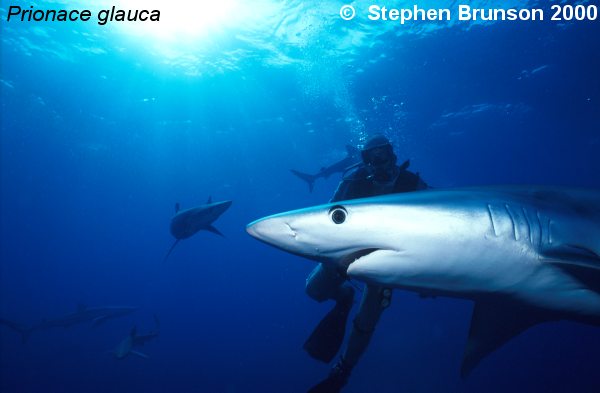








Blue Shark: Prionace glauca
The strikingly beautiful blue shark, Prionace glauca, holds the record for longest distance traveled: 3,716 miles across the Atlantic, averaging nearly forty-four miles a day. Another blue, tagged off New York City, was found 3,740 miles off the coast of Brazil, establishing for the first time that blue sharks in the Western Atlantic cross the equator. The world's most abundant oceanic shark, the blue is a migrant in both the Atlantic and Pacific, but little is known about its migrations. Research based on blue shark tagging has indicated that they travel with the seasons as water cools. They also appear to have mating grounds in several areas, including the north Pacific and off Portugal. An important food fish in many places, the blue shark is also caught frequently on long-lines and drift nets set for tuna, swordfish, and other commercial fish. An estimated 6.2 to 6.5 million blue sharks are caught and killed each year. Mating, which has not been observed, apparently is rough. The female has skin twice as thick as the male, thicker than his teeth are long! What appears to be scars of bites on females are not found on males.

Print Number - SH010
Limited Edition signed color photography for sale by Stephen Brunson
Blue Shark, Prionace glauca Statistics:
Weight: Up to 600 Lbs.
Length: Up to 14 Ft.
Sexual Maturity: 5 years
Mating: Late Spring or Early Winter.
Number of Young: 20 - 135 pups at one time!
Gestation Period: 9 Months to a Year.
Typical Diet: Great quantities of Squid and Bluefish. They can digest nearly three pounds of fish a day.
Distribution: Worldwide in tropical and temperate seas.
Danger to Humans:
Blue sharks usually seem merely inquisitive and shy, circling around divers and swimmers, but they have attacked
people. Blue sharks are also blamed for feeding frenzies on survivors of World War II ship sinkings.
BrunsonImages@att.net


















